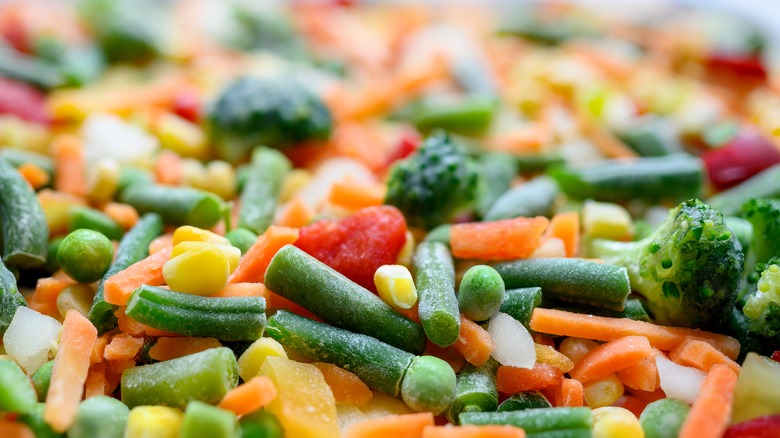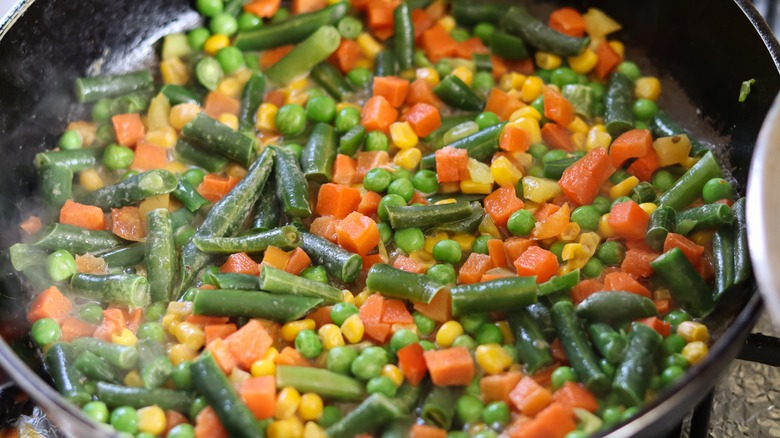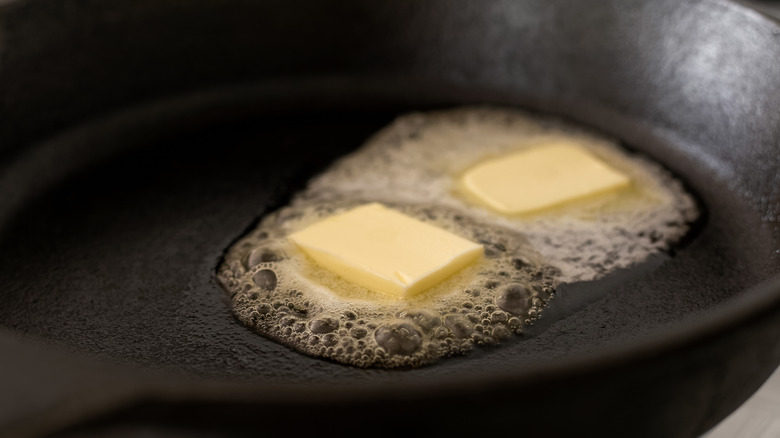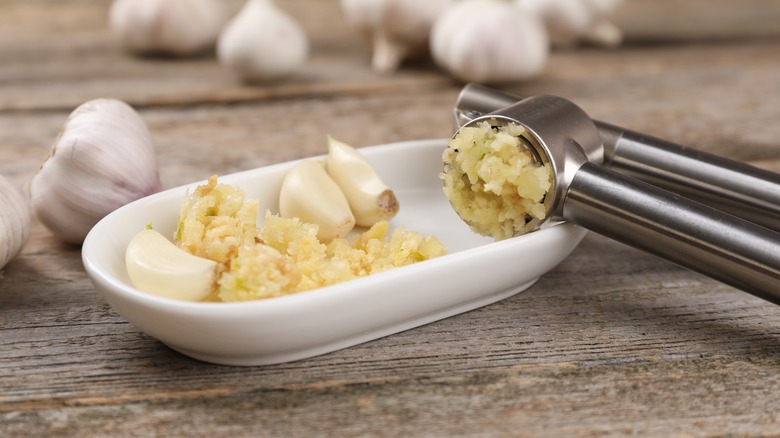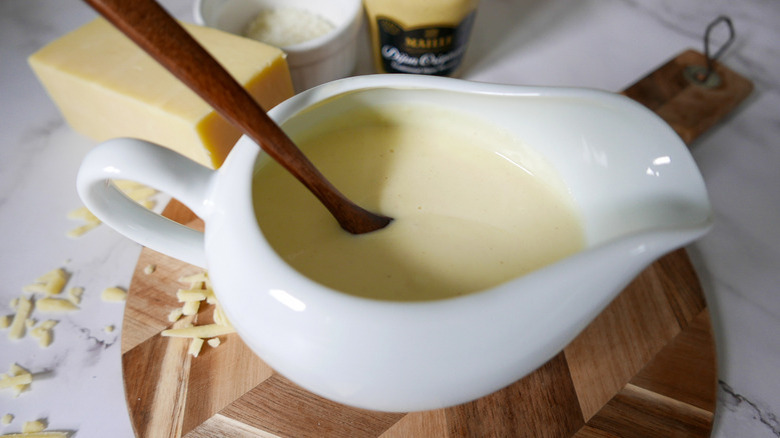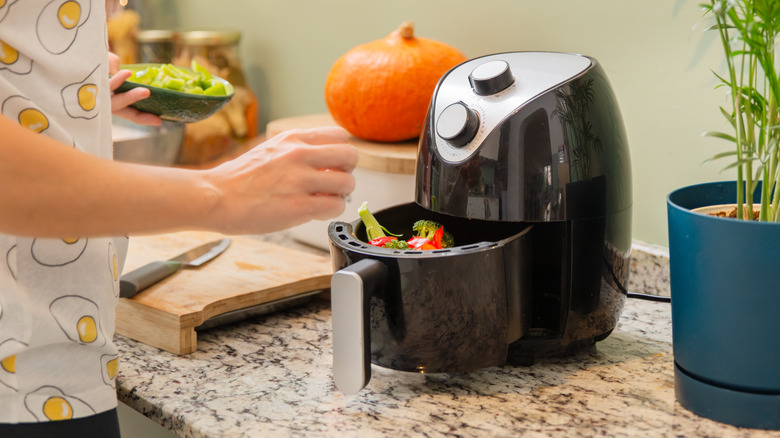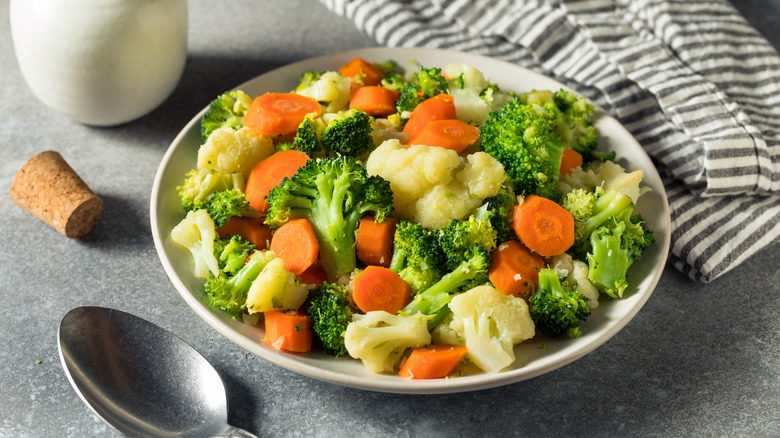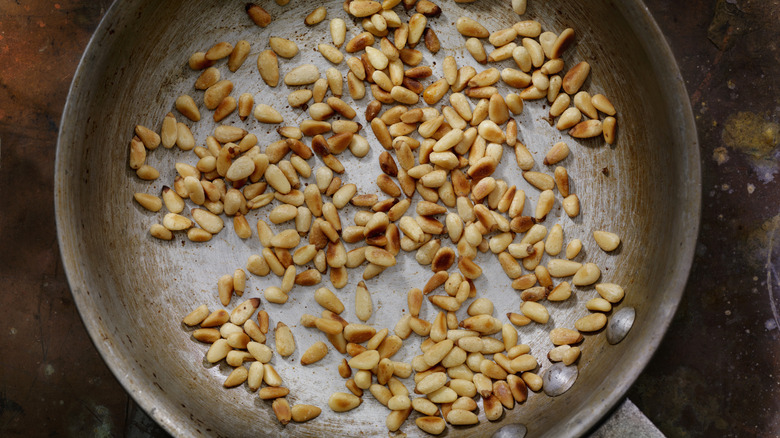12 Simple Ways To Make Frozen Vegetables Taste Amazing
Frozen vegetables can be a lifesaver that help you prepare easy yet balanced and nutritious meals when you're short on time. They're convenient, affordable, and can be stored in the freezer for long periods of time, ready to add color to your plate whenever you need them. But let's be honest: sometimes they can be a little lackluster in the flavor department. If you've ever found yourself staring at a bag of frozen broccoli or peas, wondering how to turn them into something you'll actually enjoy eating, you're not alone.
The good news is that with a few simple tricks, you can transform frozen vegetables into something a lot more tempting. Even if you're pressed for time, these methods are easy enough to incorporate into your weeknight dinner prep. From simple tweaks in your cooking methods to a range of delicious add-ins, these ideas will help you to maximize the flavor of frozen veggies with minimal effort. There won't be a soggy green bean or a tasteless carrot in sight!
So, the next time you want a quick, healthy addition to your meal, try one (or more) of these tricks and give your frozen veggies the flavor makeover they've been waiting for.
1. Sauté them in a skillet
One of the quickest and easiest ways to bring frozen vegetables to life is by sautéing them in a frying pan. Use this cooking method and you'll have a large amount of control over the texture and flavor of the veggies, ensuring they turn out perfectly tender-crisp every time with no unappetizing mushiness. Sautéing is also great for preserving the nutritional content of vegetables, which can significantly reduce with longer cooking techniques like boiling.
To sauté frozen vegetables, start by heating a tablespoon or two of olive oil (or another cooking oil of your choice) in a large frying pan over medium-high heat. Once the oil is nice and hot, add your frozen veggies straight into the pan (no need to thaw first). As the vegetables cook, stir occasionally to prevent sticking. After a few minutes, they should start to caramelize on the surface, which will add a delicious depth of flavor. You can season with salt and pepper to taste towards the end of cooking.
The sautéing process should take five to eight minutes, depending on the type of vegetables you're using. When done, you'll have a vibrant panful of vegetables that are deeply flavorful and slightly crisp. This technique will work brilliantly for all kinds of frozen veg, from a classic mixed medley of peas, corn, green beans, and carrots to bell peppers or cauliflower.
2. Cook them with butter
Another fantastic way to spruce up your frozen veggies is the simple addition of butter. This will add a wonderful richness to the vegetables, enhancing their natural flavors and making them taste downright luxurious.
You can either opt to pan-fry your veg in butter or add the butter after using another cooking method such an oven-roasting or steaming. For the pan-frying method, start by melting two to three tablespoons of butter in a large frying pan over medium heat. Adjust this amount depending on your preference and the volume of vegetables you're cooking up. Once the butter is melted and foamy, add the frozen vegetables to the pan and cook until they become tender and caramelized.
To add butter post-cooking, simply melt it in a saucepan (or in the microwave, going in short bursts of time to avoid popping butter). Then, pour it over the cooked vegetables and toss well to coat. You could also add some seasonings of your choice to the butter, such as salt, pepper, garlic powder, or Italian herbs. Your veggies should now be packed with rich, buttery flavor, making them perfect for serving as a wholesome side for meats, tossing into a grain bowl, or incorporating into your favorite pasta dish.
3. Squeeze over some lemon juice
To bring fresh, zesty flavor to your frozen vegetables, trying adding a squeeze of lemon juice. This can work wonders by bringing some much-needed brightness to what would otherwise have been a basic, bland side dish.
After cooking your frozen vegetables using your preferred method, simply remove them from the heat and squeeze fresh lemon juice over the top. The acidity of the lemon wonderfully balances the natural sweetness of many types of vegetables. You won't need a huge amount of juice to enhance the flavor of the veg — about half a lemon's worth should work, though of course you can adjust this to taste as needed. For a more intense citrus flavor, try adding some lemon zest, which will make everything extra fragrant.
Lemon juice pairs beautifully with green vegetables like broccoli, green beans, and asparagus, though it can also bring out the best in carrots, cauliflower, or peas. You'll find that lemon combines well with other herbs and aromatics as well, like garlic, parsley, basil, or mint. So, don't hesitate to continue the sprucing-up process with some extra additions.
4. Add garlic
Garlic is an essential ingredient in a huge range of dishes, as it can dramatically transform the overall flavor of a meal with its savory, aromatic qualities. It's therefore unsurprising that garlic has the ability to make even the simplest of frozen vegetables shine. This beloved cooking staple is the perfect ingredient for adding depth and an enticing aroma to your veggies.
To infuse your frozen veggies with garlicky goodness, first mince a few cloves of fresh garlic. Heat a tablespoon of olive oil or butter in a pan over medium heat, then add the minced garlic and sauté for one minute until it's fragrant and just starting to turn golden. Be careful that it doesn't burn, as this can leave your veggies with a bitter taste. Next, add your frozen vegetables and continue sautéing until they're heated through and tender, usually around five to eight minutes.
The addition of garlic will work great with a variety of frozen vegetables, including spinach, broccoli, and mixed veggie blends. For even more aroma and flavor, add some finely diced onions to the pan before you cook the garlic and veg. Or, for some extra heat, sprinkle a pinch of red pepper flakes over the vegetables.
5. Add bacon
If you're looking to amp up the savory flavor of your frozen vegetables, bacon is your friend. Its smoky, salty flavor is just right for elevating tender veggies, turning them into something wonderfully indulgent and satisfying.
Firstly, you'll want to cook the bacon using your preferred best method. Pan-frying is a great option, as this will allow you to preserve the bacon fat for extra flavor. Just add the bacon to a cold pan — no oil needed for this fatty meat —then turn the heat to low-medium and cook until browned and crisp, flipping occasionally. Avoid starting with a hot pan, as this can cause the bacon to burn and stick. The low and slow method will melt the bacon fat slowly and allow it to crisp up perfectly during cooking.Next, remove the bacon from the pan, and once it's cool enough to handle, chop it up into small pieces and set these aside.
Now, turn the heat up to medium-high, leaving the bacon fat in the pan. Add your frozen veg to the hot bacon fat, and sauté until tender-crisp. Finally, return the bacon pieces to the pan and stir well to combine. Your veggies will now be infused with a deliciously rich and savory flavor. If using another method to cook either your vegetables or bacon, simply toss together the two elements together in a bowl post-cooking.
6. Slather them in cheese sauce
Cheese sauce is a game-changer for an array of recipes, including pastas, casseroles, burgers, and nachos. So, why aren't you using this indulgent sauce on frozen veggies? It's rich, creamy, and full of flavor that's sure to turn simple veggies into a decadent, comforting, and totally irresistible dish.
Whipping up a quick cheese sauce at home is easy enough. Start by melting butter in a saucepan, then stirring in flour to create a roux. Next, add a little minced garlic and stir until fragrant. Now you pour in milk, whisking as you go until you have a smooth, thick sauce. The final step is adding your favorite cheese. A combination of shredded cheddar and Parmesan works beautifully, while a dash of Dijon mustard adds extra tang. Stir everything until wonderfully melty and gooey, and your sauce is ready to use.
To prep them for their cheesy transformation, first cook the frozen vegetables. Cheese and cauliflower or broccoli are a match made in heaven, but you can use just about any vegetable here, so feel free to grab whatever you have on hand. Next, spread the cooked veg out in a baking dish and pour the cheese sauce evenly over the top. Place this mixture under a preheated broiler until the sauce bubbling and browned — about five minutes — and it'll be ready to serve.
7. Season them with your favorite herbs and spices
We add herbs and spices to meats, stews, and dressings without a second thought, but it's easy to forget that vegetables can be also benefit from their deliciousness. Whether you prefer a subtle hint of flavor or something more adventurous, seasoning your veggies has to be one of the easiest ways to make them taste amazing.
A great method to infuse your frozen veggies with herbs and spices is to pan-fry them. Just add the herbs and spices about half way through the cooking process. If you're steaming or boiling the vegetables, it's easier to season them after cooking. Try mixing your herbs and spices with a little oil or melted butter, then tossing this mixture together with the cooked veggies.
There are practically endless flavor combinations to try here. For a classic, all-purpose flavor boost, use a combination of garlic powder, onion powder, salt, and black pepper. If you're looking to add a bit more of a kick, add a dash of smoked paprika, chili powder, or red pepper flakes. Herbs like oregano, rosemary, thyme, or basil can also add a burst of freshness and color to your dish.
8. Cook them in the oven or air fryer
To get your frozen vegetables beautifully charred and packed with flavor, try roasting them in the oven or air fryer. This is guaranteed to enhance their taste and texture, giving them a wonderfully caramelized exterior while keeping them perfectly tender on the inside.
Consider roasting veggies first with zero additions. That's right — no oil, no salt, no herbs or spices. This is because you don't want to add anything that might trap water into the vegetables, which could make it soggy. Simply preheat your oven to 400 degrees Fahrenheit, place the frozen vegetables on a baking sheet, and pop them in the oven for 25 minutes. After this time, they should be lovely and browned around the edges. Now is the perfect time to add your seasonings. Toss the vegetables with oil, salt and pepper, and any desired herbs or spices, and place back into the oven for another eight minutes.
If using an air fryer, place the vegetables on top of the grates rather that in the bottom of the basket, so any excess water can drain away and not collect around the vegetables. This way, you can skip the pre-roasting. Just toss the veg with oil and seasonings and air fry at 400 degrees for 14-16 minutes, stopping to shake the basket and drain any excess water halfway through cooking.
9. Opt for steaming over boiling
Steaming is an excellent way to preserve nutrients and color while keeping vegetables relatively crisp. Compared to boiling, steaming will cook the vegetables more gently, since they don't get fully submerged in water. Steamed vegetables will also retain more vitamins and minerals, as these won't leach out into a cooking liquid that's then discarded.
To steam frozen vegetables, you'll need a steamer basket or a microwave-safe bowl with a lid. If you're using a steamer basket, bring a pot containing two to three inches of water to a simmer over medium heat. Place the vegetables in the basket and set it over the simmering water, making sure the water doesn't touch the veggies. Cover with a lid and steam the vegetables until tender. The exact cooking time will depend on the type of vegetable you're using. While peas will be ready in about three minutes, cauliflower or cabbage might take up to 10.
For the microwave method, add your frozen vegetables to the bowl with two tablespoons of water. Cover with a lid and microwave on high until the veg is tender — typically about six minutes. Once steamed, drain away excess water. Steaming vegetables doesn't mean you have to eat them unseasoned, either. Give them a delicious upgrade after cooking by adding your favorite herbs, spices, or aromatics.
10. Simmer in chicken broth
Simmering frozen vegetables in chicken broth is a great way to infuse them with a delightful savory flavor while keeping them tender and juicy. This method adds a wonderful depth to frozen vegetables, giving them an edge that takes a meal from bland to irresistible. Both store-bought and homemade broth will work brilliantly here.
Heat your broth of choice in a high-sided pot or pan over medium heat. One cup of broth should be just the right amount for a 16-ounce bag of frozen vegetables. Bring the broth to a simmer, then add your vegetables. They should take between five and 10 minutes to cook. Once sufficiently infused and tender, drain the veg.
At this point, you can serve it as-is or add some additions to enhance the natural flavors of the vegetables. Return the veg to the pan with a little butter and minced garlic for a rich and aromatic result. Or sprinkle with freshly chopped herbs or Parmesan cheese just before serving.
11. Add toasted nuts
Introducing toasted nuts to your frozen vegetable medley is sure to add amazing texture and a distinct nutty flavor, all while providing extra nutrients, too. That crunch serves as the ultimate contrast to the tender vegetables, creating a super satisfying final dish.
One option is to toast the nuts separately and scatter them over the vegetables right before serving. This is great if you're steaming, boiling, or pan-frying frozen veggies. Toasting nuts is a simple process. For stovetop toasting, place a dry skillet over medium heat. Add your choice of nuts and cook, stirring frequently, for about three to four minutes or until they're golden brown and fragrant. If using the oven, preheat to 350 degrees Fahrenheit, spread them out on a baking sheet, and toast for eight minutes.
If you're opting to oven-roast your vegetables, toss the nuts in right alongside them. Just scatter them on top of your prepared frozen veggies on the baking sheet and roast until the nuts are golden brown and the vegetables are tender. Nuts pair well with a range of vegetables. We love to serve them with green beans, Brussels sprouts, sweet potatoes, and butternut squash.
12. Add soy sauce
If rich, umami flavors are your thing, soy sauce is a must-add ingredient to frozen vegetables. This simple condiment can provide a rich, salty kick that gives your veggies a major boost in the taste department.
Pan-frying is an ideal cooking method here. First, add oil to a frying pan or wok over high heat, and sauté the vegetables for a few minutes until tender. Then, pour in one to four tablespoons of soy sauce, depending on the quantity of vegetables you're cooking. Stir well, and continue cooking for another few minutes so the vegetables can absorb the delicious flavors.
Soy sauce will also taste fantastic when accompanied with other Asian-inspired ingredients, like rice vinegar and sesame oil, or aromatics such as minced garlic and ginger. A drizzle of maple syrup is great for bringing a touch of balancing sweetness, too. If using extra flavor additions like these, combine them in a small bowl with the soy sauce first, then pour over the vegetables in the pan. To create a thicker, stickier mixture that'll cling to the vegetables more effectively, stir in a tablespoon of corn starch while preparing your sauce.
